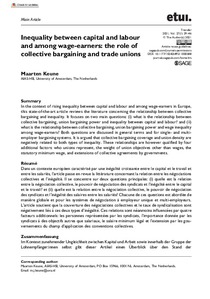Inequality between capital and labour and among wage-earners: the role of collective bargaining and trade unions

Transfer. European Review of Labour and Research
2021
27
1
February
29-46
collective bargaining ; labour relations ; wage differential ; income distribution ; equal pay ; trade union
Labour relations
https://doi.org/10.1177/10242589211000588
English
Bibliogr.
"In the context of rising inequality between capital and labour and among wage-earners in Europe, this state-of-the-art article reviews the literature concerning the relationship between collective bargaining and inequality. It focuses on two main questions: (i) what is the relationship between collective bargaining, union bargaining power and inequality between capital and labour? and (ii) what is the relationship between collective bargaining, union bargaining power and wage inequality among wage-earners? Both questions are discussed in general terms and for single- and multi-employer bargaining systems. It is argued that collective bargaining coverage and union density are negatively related to both types of inequality. These relationships are however qualified by four additional factors: who unions represent, the weight of union objectives other than wages, the statutory minimum wage, and extensions of collective agreements by governments. "
Digital;Paper
The ETUI is co-funded by the European Union. Views and opinions expressed are however those of the author(s) only and do not necessarily reflect those of the European Union or the ETUI.